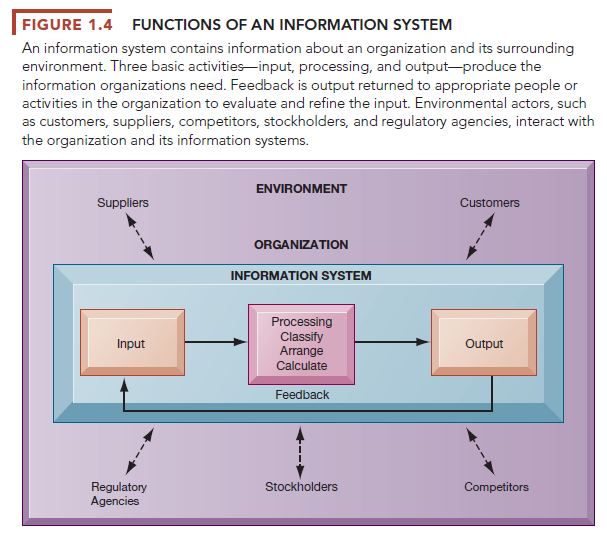An information system can be defined technically as a set of interrelated components that collect (or retrieve), process, store, and distribute information to support decision making and control in an organization. In addition to supporting decision making, coordination, and control, information systems may also help managers and workers analyze problems, visualize complex subjects, and create new products.
Information systems contain information about significant people, places, and things within the organization or in the environment surrounding it. By information we mean data that have been shaped into a form that is meaningful and useful to human beings. Data, in contrast, are streams of raw facts representing events occurring in organizations or the physical environment before they have been organized and arranged into a form that people can understand and use.
A brief example contrasting information and data may prove useful. Supermarket checkout counters scan millions of pieces of data from bar codes, which describe each product. Such pieces of data can be totaled and analyzed to provide meaningful information, such as the total number of bottles of dish detergent sold at a particular store, which brands of dish detergent were selling the most rapidly at that store or sales territory, or the total amount spent on that brand of dish detergent at that store or sales region (see Figure 1.3).

Three activities in an information system produce the information that organizations need to make decisions, control operations, analyze problems, and create new products or services. These activities are input, processing, and output (see Figure 1.4). Input captures or collects raw data from within the organization or from its external environment. Processing converts this raw input into a meaningful form. Output transfers the processed information to the people who will use it or to the activities for which it will be used. Information systems also require feedback, which is output that is returned to appropriate members of the organization to help them evaluate or correct the input stage.
In PCL’s project management system, input includes the names and addresses of contractors and subcontractors, project names and identification numbers, project activities, labor costs, materials costs, and start and completion dates for project activities. Computers store these data and process them to calculate how much each project activity and the entire project will cost and estimated completion time. The system provides meaningful information such as the size, cost, and duration of all projects under PCL management, projects over and under budget, and projects and project activities that are late or on time.
Although computer-based information systems use computer technology to process raw data into meaningful information, there is a sharp distinction between a computer and a computer program on the one hand and an information system on the other. Computers and related software programs are the technical foundation, the tools and materials, of modern information systems. Computers provide the equipment for storing and processing information. Computer programs, or software, are sets of operating instructions that direct and control computer processing. Knowing how computers and computer programs work is important in designing solutions to organizational problems, but computers are only part of an information system.
A house is an appropriate analogy. Houses are built with hammers, nails, and wood, but these do not make a house. The architecture, design, setting, landscaping, and all of the decisions that lead to the creation of these features are part of the house and are crucial for solving the problem of putting a roof over one’s head. Computers and programs are the hammers, nails, and lumber of computer-based information systems, but alone they cannot produce the information a particular organization needs. To understand information systems, you must understand the problems they are designed to solve, their architectural and design elements, and the organizational processes that lead to the solutions.

Source: Laudon Kenneth C., Laudon Jane Price (2020), Management Information Systems: Managing the Digital Firm, Pearson; 16th edition.

I blog often and I truly appreciate your information. This article has truly peaked
my interest. I am going to take a note of your site and keep checking for
new details about once a week. I opted in for your RSS
feed too.
It’s not my first time to pay a quick visit this website, i am browsing
this site dailly and get fastidious facts from here everyday.
This excellent website definitely has all the
information I wanted about this subject and didn’t know who
to ask.